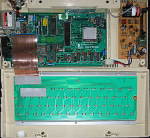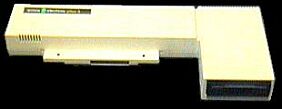|
Electron
 |
The Beeb was a relatively expensive machine to buy. To address this problem, Acorn introduced in 1983 a cut-down version of the Model B, the Acorn Electron.
The hardware was similar to the Beeb, the same processor, the 6502A, operating system and BASIC variant (BBC BASIC II). |
 |
However, much of the functionality of the Electron was contained in a single ULA. The Electron did not have the circuitry to display the Beeb's teletext mode. Besides that there were also a number of other hardware differences.
The basic Electron had only six ports (power supply in, TV out, video out, RGB monitor out, cassette interface and expansion connector) it was relatively easy to expand, mainly due to Acorn's Plus 1 and Plus 3 add-ons. (if available) The Plus 1 plugged in to the expansion connector and added two cartridge slots, a printer interface and the ability to add extra ROMs to the system.
| 
|
| The Plus 3 was a complete 3.5" disc drive system that also plugged directly in to the expansion slot. A Plus 1 could then be added using an expansion slot on the back of the Plus 3. This device also came with an uprated power supply unit, to cope with the extra demands made by the floppy drive. A number of companies, such as Slogger and Pres, manufacted peripherals that made use of the expansion connector.
The Electron has never enjoyed the popularity of its larger brother |

Acorn Plus 1 |

Acorn Plus 3 |

|
|
|
Hardware specifications
¤ CPU: MOS Technology 6502A
¤ Clock rate: variable. CPU runs at 2 MHz when accessing ROM and 1 MHz or 0.5897 MHz
(depending on graphics mode) when accessing RAM due to sharing memory access with
the video display circuits. The Electron is widely misquoted as operating at 1.79 MHz after
measurements derived from speed testing against the thoroughly 2 MHz BBC Micro for
various pieces of 'common software'
¤ Coprocessor: Custom ULA
¤ RAM: 32 KB
¤ ROM: 32 KB
¤ Text modes: 20×32, 40×25, 40×32, 80×25, 80×32 (all text output produced by software in graphics modes)
¤ Graphics modes:
160×256 (4 or 16 colours),
320×256 (2 or 4 colours),
640×256 (2 colours),
320×200 (2 colours — spaced display with two blank lines following every 8 pixel lines),
640×200 (2 colours — spaced display)
¤ Colours: 8 colours (TTL combinations of RGB primaries) + 8 flashing versions of the same colours
¤ Sound: 1 channel of sound, 7 octaves; built-in speaker. Software emulation of noise channel supported
¤ Dimensions: 16×34×6.5 cm
¤ I/O ports: Expansion port, tape recorder connector
(1200 baud variation on the Kansas City standard for data encoding),
aerial TV connector (RF modulator), RGB video monitor output
¤ Power supply: External PSU, 18V
|
|
|
